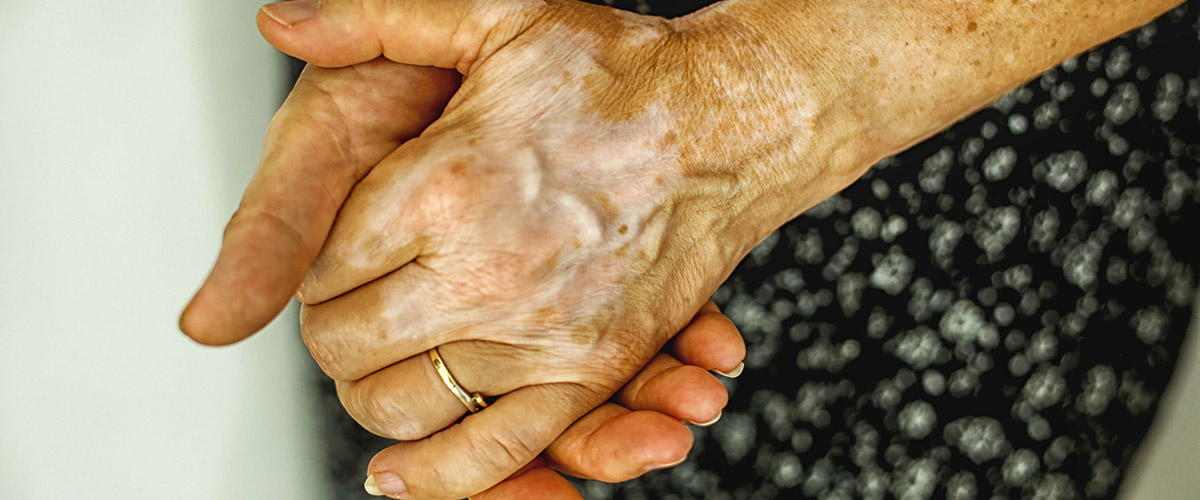
Bullous pemphigoid, a severe blistering skin condition, is a rare auto-immune disease which mainly affects elderly people. The aim of the BLISTER study was to find out whether starting treatment with a commonly-used antibiotic would be effective and a safer alternative to oral steroids – which can cause long term side effects.
Published: 15 July 2019
The BLISTER study was funded by the NIHR Health Technology Assessment (HTA) programme and supported by the NIHR Clinical Research Network. Find out about the support available from NIHR for dermatology research here.
Impact case study - BLISTER
BLISTER (Bullous Pemphigoid Steroids and Tetracyclines Study)
Bullous pemphigoid, a severe blistering skin condition, is a rare auto-immune disease affecting mainly elderly people. The patient’s immune system mistakenly makes antibodies against the area between the top layer of skin (epidermis) and the next layer (dermis). This causes painful skin erosions, itchy rashes and blisters on the body which can become infected if they burst. Between 20 and 40 per cent of patients die within one year of diagnosis.
Oral steroid tablets are commonly used to treat bullous pemphigoid. They work well, but can cause long term harmful side effects including infection, high blood pressure, brittle bones, eye problems and diabetes. Antibiotic tablets are also used and are thought to work almost as well as oral steroids, but their side-effects are less serious. The aim of the BLISTER study was to find out whether starting treatment with a commonly-used antibiotic ‘doxycycline’ would be an effective and safer alternative to the current standard treatment of the oral steroid ‘prednisolone’. Participants were randomly allocated (by chance) to take either doxycycline tablets or prednisolone tablets.
A total of 253 patients were recruited of which 132 started treatment on doxycycline and 121 started treatment on prednisolone. After six weeks, patients could switch treatments or increase the dose of prednisolone as needed, as would typically occur in standard practice. In the first six weeks patients knew which medication they were using, however their doctor did not. This meant that the treatment response could be assessed in an unbiased way. Treatment success depended on the number of significant blisters after six weeks (more than three) and the side effects that occurred over the course of a year, and how serious they were.
Key features
- The trial ran from October 2008 to September 2013
- 253 patients were recruited from 54 hospitals across the UK and seven hospitals in Germany, to time and target
- The study was funded by the NIHR Health Technology Assessment Programme
- The NIHR Clinical Research Network supported and monitored patient recruitment
- Chief Investigator: Professor Hywel Williams, University of Nottingham
Outcomes and findings
Results showed that starting treatment with an oral antibiotic (doxycycline) is an acceptable and safer alternative to the current standard treatment of oral steroids (prednisolone) which can have harmful long-term side effects. Prednisolone was slightly more effective in controlling symptoms of the disease but it carried a higher risk of severe, life threatening and fatal side effects. For those patients given doxycycline, 74 per cent had three or fewer blisters after six weeks compared to 91 per cent of patients given prednisolone.
However, only 18 per cent of patients (two in ten) on doxycycline suffered serious adverse side effects after one year, compared to 36 per cent of patients (four in ten) on prednisolone. The results were about the same for people who had mild, moderate or severe bullous pemphigoid.
Value to the NHS
“Pemphigoid can be a life changing skin blistering disease for the elderly, with sometimes devastating side effects from the standard treatments. BLISTER opens a new pathway to these people, offering a way for them to stay healthy and strong during treatment.”
Dr Nick Levell National Specialty Lead for Dermatology NIHR Clinical Research Network
Although fewer patients starting on doxycycline had a good early treatment response compared with prednisolone, many patients (almost three quarters) did have a good treatment response. Additionally, these patients had better outcomes as they did not experience as many severe, life threatening or fatal side effects in the long term.
This study gives doctors and patients another option for treating bullous pemphigoid which is less toxic. Doxycycline, although not quite so effective in the short term, is a significantly safer treatment in the long term. Treatment of the disease can extend for months or years. During this time patients may be admitted to hospital or have to attend frequent outpatient appointments for treatment of their side effects. Therefore, better patient outcomes will be a cost saving to the NHS.
Study findings were recently published in the Lancet and are yet to make their way into published guidelines. The UK Dermatology Clinical Trials Network has been involved throughout the research study and is now utilising its’ membership in a series of pre and post-publication surveys to assess the impact of the study results on clinical practice and everyday clinical care.
“Although the safest form of treatment for pemphigoid are steroid creams applied in large quantities to the skin for long periods, such treatment is not practical for everyone, and tablet treatments are needed. Steroid tablets are good at controlling blisters, but they have serious long term side effects in the elderly. Starting treatment with antibiotics offers reasonable short-term blister control with much better long-term safety when compared with oral steroids.”
Professor Hywel Williams Chief Investigator University of Nottingham
Key publications:
- Study site: www.blistertrial.co.uk
- The results were published in The Lancet on 6 March 2017

